About us
JAXA Aviation helps to create a safer and more prosperous society with aeronautics-related research and development activities.
FLIGHT PATH No.23 | 2019 SUMMER
<Advanced research into composite materials and structures>
Optimum design technology and Bionic Airframe innovating airframe structures competing with overseas technologies
Composite optimization allows composite structures to be designed in an optimum and more efficient manner, which requires a different approach from those applied to conventional metal structures. AOKI Yuichiro introduces JAXA’s unique approach on design technology adaptable to Automated Fiber Placement (AFP) technology and Bionic Airframe which would innovate airplane structures.
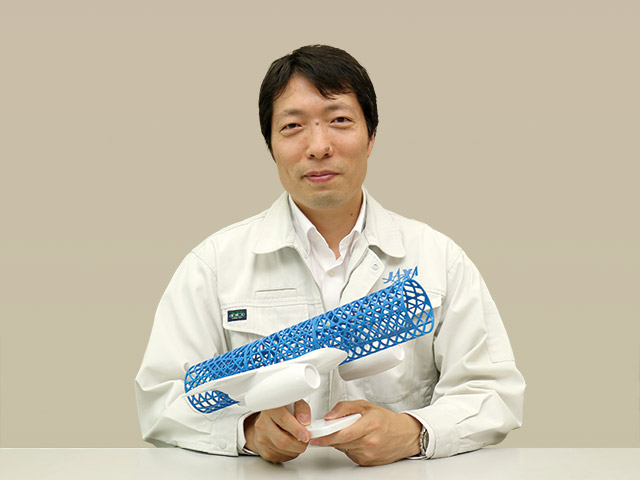
AOKI Yuichiro
Associate Senior Researcher
Structures and Advanced Composite Research Unit
Cost reduction by automated manufacturing process is the global trend
What are the global trends surrounding composite materials in the aviation field?
While the use of composites in aircraft has been getting popular, Boeing and Airbus are now eager to find ways to suppress the fabrication cost of composite airframe. Demands for the cost reduction are extremely strong for single-aisle aircraft that are popular among low-cost carriers in particular and more than 12,000 of narrow-body airplanes are flying around the world. So airframe makers are trying to automate most of their manufacturing processes for composite airframes. In addition, they plan to optimize the advantages of composite materials by combining airframe design process with automated production technologies. There is such a big flow.
Does it mean that Japan’s conventional manufacturing processes won’t be able to deal with the global movement?
I think it is very likely to happen. We make composites by laminating fiber-reinforced plastic sheets called “prepreg” (an intermediate material made of aligned fibers and impregnated resins). We produce an optimum shape by overlaying more sheets at those places to be thickened and less sheets at places to be made thin. A considerable part of conventional composite material manufacturing processes require manual work. Recently, however, Boeing and Airbus extensively implement in their manufacturing plants automated fiber placement machines made by industrial tooling makers. Automated machines can fabricate complicated shapes and drastically reduce labor cost. But we don’t have the automated fiber placement technology in Japan. That is why research of the technology is underway in the government project Cross-ministerial Strategic Innovation Promotion Program (SIP).
Automated Fiber Placement (AFP) technology is indispensable for optimum design
What is your specific idea of an optimal design adaptive for composites?
Metal materials have a uniform property in all directions. If we change the stacking order and the direction of prepreg, however, composites can have anisotropy as being strong in a certain direction or soft in another. We take advantage of these characteristics unique to composite materials. Take a main wing for instance, it will be possible to design such a wing that is very strong against upward and downward bending loads and flexible for torsion or a wing that has an unprecedented function as twisting in a certain direction when it is bent. Another example is that we have to increase the thickness of certain components around maintenance holes or other cut-outs. The reason is that stress concentration occurs in the vicinity of holes and thus strength must be kept in those areas. The use of composites enables to increase the strength without increasing weight by controlling the percentage of reinforcing fibers or realizing the optimum distribution of thickness.
Does it mean that those ideas of optimal design will lead to AFP technology?
Exactly. One of the purposes of SIP is for Japan to possess AFP technology. JAXA additionally intends to establish a complete set of design and manufacturing technologies by linking optimum design and AFP technology. Please let me speak about a little-bit basic story. Carbon fiber reinforced plastic (CFRP), a synonym of composite materials, seems to be understood but really not. For instance, the mechanism of strength deterioration has not been clarified completely. So, simulation technology hasn’t been established yet to predict the strength of CFRP accurately. Strength tests of composites are costly, so we want to replace real tests with simulation as much as possible. However, it is actually a big problem. We are now engaged in research to develop firstly a new simulation technology capable of making accurate strength predictions and then utilize the simulation technology to design materials and airframes which can satisfy design requirements for aircraft. Without this research, we cannot perform optimum design in its true meaning.

Left: Tailored layup by automated fiber placement
Right: Prototype of optimal layup panel. The optimization of thickness and the automated fiber placement decreased weight by approximately 40 percent.
You also work on thin-ply technology at SIP, don’t you?
It is a very important technology. The thickness of conventional CFRP prepreg sheets used in JAXA’s structures and advanced composite research is 0.15 to 0.2 mm. They are relatively thick. Thin-ply means its thickness is one-third or even a quarter of such values. At a location where you would use 10 sheets of an existing material for instance, you can laminate 30 sheets of a thin-ply material. Overlaying fibers in various orders and combinations of directions will provide unprecedented characteristics. We call the process “tailoring.” It will make it possible to put thin layers in a way to get desired physical properties just like tailored clothes. However, the total number of layers will increase, which is tough for manual work. So, we need automate the process of tailored layering. Composite materials made of laminated thin-plies have good resistance against crack initiation and subsequently have better strength than conventional prepreg laminates. As it gets stronger, the thickness can be less than ever before.
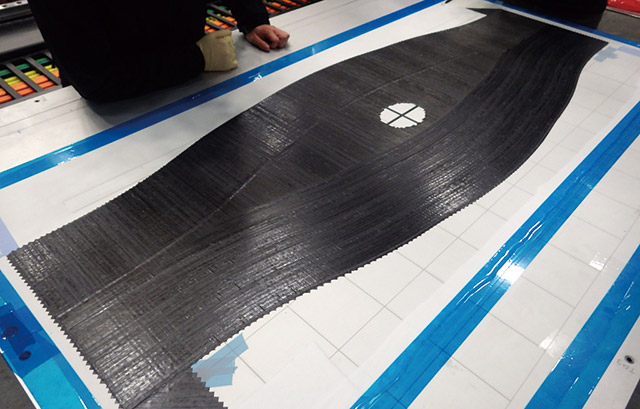
Specimen that carbon fiber tapes are curvilinearly
laminated by automated fiber placement
Bionic Airframe as an ultimate shape of design optimization
What is the Bionic Airframe technology which is said to have brought up the optimum design of composite materials to its ultimate shape?
The Bionic Airframe is based on what we have learned from living organisms. The word “bionic” means “superhuman” and “exceptionally strong” as well. We want to create an ultimate optimum structure which has both properties. It means that we’re going to take the idea of biomimetics into the airplane structure. Every structure of living beings has a specific function. I think that is probably because it is the best optimized structure. Introducing biomimetics to aircraft fuselage and feeding it back to the airframe design, you will get a structure similar to the ribs of a pterosaur. By adapting a structure that is inspired by skeletons of living organisms, we think it may be possible to make an airframe which is much lighter and having higher functionality than present ones.
Is it possible to develop a new structure for main wings based on the idea?
As a matter of fact, our present target is the main wing. Making a main wing structured like the framework of living organisms, analyzing how much strength the wing could have, and making another main wing by importing the analysis data into our automated fiber placement machine. We’ve been doing that kind of manufacturing trial since 2018.
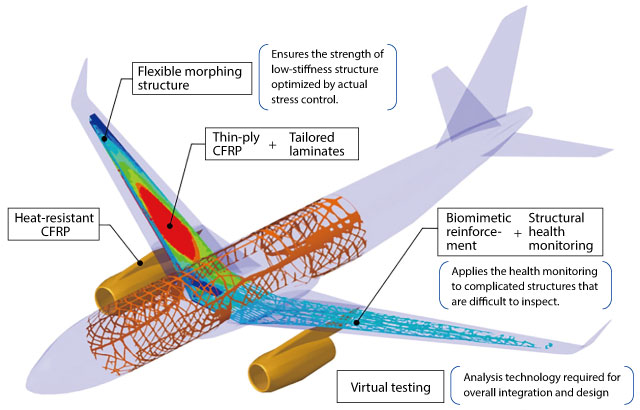
JAXA's Bionic Airframe to meet new demands in aircraft development
JAXA is now conducting the study of morphing wings which can continuously change their shapes. It’s possible for the Bionic Airframe technology to bring morphing wings into reality, isn’t it?
Yes, I think it’s possible. For example, the central part of a main wing must be strong and stiff in order to support flight loads. But the trailing edges may be made flexible to have the function of control surface. I believe that the use of Bionic Airframe technology can solve it with a single integrated structure. We put a lot of fibers into the central part along the direction of loads. At the edges, we put only fibers in such directions that will be very flexible. We can make flexible and rigid parts within a single structure.
In other words, moving parts such as flaps can be integrated into the main wing.
The present design of main wings has separate flaps. It has hinges to connect flaps to wingbox and actuators to operate flaps. We will integrate all of them into the main wing. We have a specific idea that we move wingtips by mounting small motor-driven actuators at the ends of main wings. So, the main wings can partially bend to steer the airplane though they are one-piece wings. We can create such a morphing wing.
If such optimization largely advances, the shape of aircraft will be no longer of the traditional “Tube and Wing.”
It’s quite possible. If we think about an airframe of entirely new structural type or concept, a completely different shape from the traditional design would be intriguing. If we use the morphing technology, for example, we could optimize airframe configuration along with flight speed. Birds slightly change the shape of wings while flying. Similarly, airplanes will optimize its configuration according to flight conditions, which would allow aircraft to have much higher functions.
Learn from the evolution of ocean sunfish and falcon
Do you need to study on real life forms if you want to learn from living organisms?
Yes. We are now planning to make an airframe structure that is based on the skeleton layout of ocean sunfish. So, we had learned from fish experts. Also, we borrowed a sample of sunfish from the National Museum of Nature and Science in Tokyo and x-rayed it to know about the skeleton layout. It may be necessary for us to keep living sunfish and study their movement (Laughs).
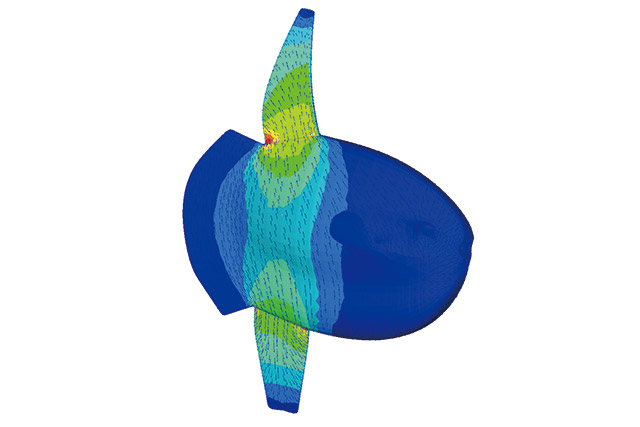
The picture shows the simulation of the way sunfish swims. Sunfish swims by moving its dorsal and anal fins simultaneously in a same phase just like a bird flutters its wings. Its caudal fin does not provide any propulsion force. The concept of biomimetics gave us a big hint for thinking about the BWB airframe structure.
How did you get the idea of Bionic Airframe in the first place?
I had known biomimetics itself that observes the structure and function of living organisms and exploit them in the development of new technologies but I did not think it would be useful for my own research. About five years ago, a task team was built to deliberate about the future vision of the Aviation Technology Directorate and I myself thought about a lot of things as a member of the team. If you work on advanced technologies only by extending the current design technologies, you would have a hard time getting anything new. If so, why not learn about totally different fields and get ideas from there, I thought. That was the very beginning.
Then I focused on living creatures. Even in strong winds, birds can fly and they do not fall down. A falcon dives down from the air above and makes a sudden stop to catch a prey. At that moment, an acceleration of more than 10 times the standard gravity is applied to its body. Falcons have strong skeleton and muscles to withstand it. This is absolutely impossible for the current airplane structures. Falcons have been evolving in that way to survive. I thought there would be something we could learn from them. Thanks to a variety of stories biologists told us, we learned a lot and I felt I can do something new.
How are biomimetics used in the aviation field overseas?
There are people who research on biomimetics in other countries as well. However, most of them are engaged in the field of aerodynamic characters or flight dynamics. There are very few researches to innovate the fundamental structure of aircraft. So, I think our research on Bionic Airframe at JAXA could be a ground-breaking one.
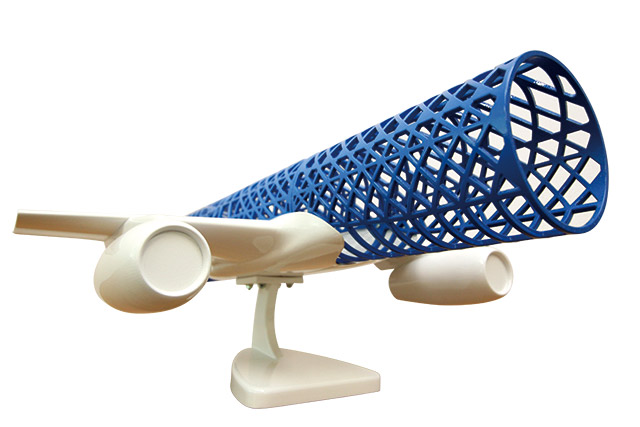
Partial fuselage model produced with 3D printer using the concept of biomimetics
Application in aircraft requires a medium to long-term perspective
What research timeline do you have in your mind?
We are going to design the research plan over this year. It would be nice if we could build a small model and fly it or carry out ground test to verify its morphing function and strength in the following five years.
The scope of research will be expanded from materials only to structure as a whole.
Up to now, we have been researching materials and measuring their strengths only as substances. However, we will perform the research in combination with design technology in order to utilize materials.
How long does it take for the technology based on the Bionic Airframe to be put in use for actual aircraft?
It will take about five years that the tailoring and optimum layup technologies I told earlier will be fully developed. The morphing technology will probably take another 10 years after that. We need to think from a middle to long-term perspective. Once flying cars or electric airplanes appear, the system of air transportation will drastically change. Then morphing technology and integrated architecture will be applicable to aircraft. I believe there will be an opportunity that the bionic airframe technology will be applicable to practical purposes in the near future.
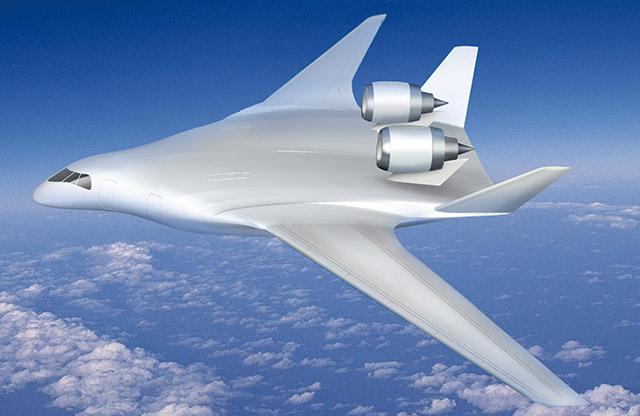
An example of future aircraft concepts applying JAXA’s structures and advanced composite technologies. Unconventional designs such as a blended wing body (BWB), having integrated wing and body configuration, would become possible with new composites and structures.
Feature Story
Advanced research into composite materials and structures